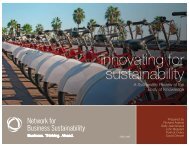embedding sustainability in organizational culture - Network for ...
embedding sustainability in organizational culture - Network for ...
embedding sustainability in organizational culture - Network for ...
You also want an ePaper? Increase the reach of your titles
YUMPU automatically turns print PDFs into web optimized ePapers that Google loves.
Chapter 1: Introduction<br />
9<br />
Every year, the <strong>Network</strong> <strong>for</strong> Bus<strong>in</strong>ess Susta<strong>in</strong>ability (nbs.net) funds systematic<br />
reviews based on the top priorities identified by its Leadership Council. In 2009-<br />
2010, the Leadership Council identified <strong>embedd<strong>in</strong>g</strong> <strong>susta<strong>in</strong>ability</strong> <strong>in</strong> corporate<br />
<strong>culture</strong> as a knowledge priority. This project aims to summarize what we know<br />
about how firms go about mak<strong>in</strong>g <strong>susta<strong>in</strong>ability</strong> an everyday, endur<strong>in</strong>g part of<br />
the organization, someth<strong>in</strong>g that has both penetration and traction. In writ<strong>in</strong>g<br />
this report, our aims were to summarize what we know (and don’t know) about<br />
<strong>embedd<strong>in</strong>g</strong> <strong>susta<strong>in</strong>ability</strong> <strong>in</strong> <strong>organizational</strong> <strong>culture</strong> and to provide a framework <strong>for</strong><br />
th<strong>in</strong>k<strong>in</strong>g about the practices that may support this process.<br />
To this end, we’ve undertaken a large-scale systematic review of both academic<br />
and practitioner sources related to <strong>embedd<strong>in</strong>g</strong> <strong>susta<strong>in</strong>ability</strong> <strong>in</strong> <strong>organizational</strong><br />
<strong>culture</strong>. Given that <strong>culture</strong> is a broad topic, we <strong>in</strong>itially cast a wide net. We identifed<br />
13,756 academic and practitioner articles and reports us<strong>in</strong>g an extensive set of<br />
keywords related to the topic. Our focus was on work that specifically addressed<br />
<strong>embedd<strong>in</strong>g</strong> <strong>susta<strong>in</strong>ability</strong>; however, we also saw the potential to learn from other<br />
well-studied analogous cultural <strong>in</strong>terventions such as health & safety, highreliability<br />
organizations, legal compliance, and the implementation of total quality<br />
management.<br />
Prelim<strong>in</strong>ary screen<strong>in</strong>g narrowed this pool to 701 of the most promis<strong>in</strong>g sources.<br />
These sources were reviewed <strong>in</strong> detail to identify 96 highly relevant materials on<br />
<strong>embedd<strong>in</strong>g</strong> <strong>susta<strong>in</strong>ability</strong>. This <strong>in</strong>cluded 82 academic articles and 14 practitioner<br />
articles and books that explored the theme of <strong>susta<strong>in</strong>ability</strong> and <strong>culture</strong>. We also<br />
reta<strong>in</strong>ed 83 sources that exam<strong>in</strong>ed analogous cultural <strong>in</strong>terventions. Us<strong>in</strong>g this data<br />
set of 179 sources, we conducted extensive, detailed analysis and synthesis of the<br />
materials to extract the various practices that may support <strong>embedd<strong>in</strong>g</strong> <strong>susta<strong>in</strong>ability</strong>.<br />
In conduct<strong>in</strong>g our review, we found <strong>in</strong>stances where practitioner knowledge leads<br />
theory. Practitioners are advocat<strong>in</strong>g practices that researchers have not yet studied<br />
<strong>in</strong> any detail. We also found numerous <strong>in</strong>stances where academics proposed<br />
practices that were not directly tested <strong>in</strong> their own work. Rather than limit our<br />
exam<strong>in</strong>ation to empirically tested practices, we identified all the relevant practices<br />
regardless of the level of empirical support and documented whether each <strong>in</strong>stance<br />
had been proposed, empirically tested and supported or was empirically tested and<br />
unsupported. Based on this analysis, we developed the framework on <strong>embedd<strong>in</strong>g</strong><br />
<strong>susta<strong>in</strong>ability</strong> presented <strong>in</strong> this report. The full details of our methods are presented<br />
<strong>in</strong> Appendix A of this report. The set of articles, reports and books that make up our<br />
data set are listed <strong>in</strong> Appendix B.<br />
Our review of previous research and practice reveals the follow<strong>in</strong>g issues:<br />
• Embedd<strong>in</strong>g <strong>susta<strong>in</strong>ability</strong> <strong>in</strong>to <strong>culture</strong> is still an emerg<strong>in</strong>g field of<br />
research. There has been a limited amount of research address<strong>in</strong>g<br />
how to embed <strong>susta<strong>in</strong>ability</strong> <strong>in</strong> <strong>organizational</strong> <strong>culture</strong>. In this area,<br />
practice often leads theory.<br />
• The research that has been conducted on <strong>embedd<strong>in</strong>g</strong> <strong>susta<strong>in</strong>ability</strong><br />
cont<strong>in</strong>ues to be dom<strong>in</strong>ated by exploratory, case-based research with<br />
an emphasis on success stories.<br />
• There is a lack of clear def<strong>in</strong>itions (what academics call construct<br />
clarity) <strong>in</strong> this field—terms are used somewhat <strong>in</strong>terchangeably and<br />
are often not def<strong>in</strong>ed.<br />
This report attempts to address some of these issues by present<strong>in</strong>g a framework<br />
to help practitioners evaluate their ef<strong>for</strong>ts to embed <strong>susta<strong>in</strong>ability</strong> and to help<br />
researchers contextualize their own work with<strong>in</strong> the larger field. Additionally, we<br />
have tried to lend ‘construct clarity’ by provid<strong>in</strong>g a set of work<strong>in</strong>g def<strong>in</strong>itions with<br />
examples to beg<strong>in</strong> to establish a common vocabulary <strong>for</strong> the field and to differentiate<br />
terms that both practitioners and academics have previously used <strong>in</strong>terchangeably.<br />
What is a <strong>culture</strong> of <strong>susta<strong>in</strong>ability</strong>?<br />
To def<strong>in</strong>e what we mean by a <strong>culture</strong> of <strong>susta<strong>in</strong>ability</strong>, it will be helpful to<br />
understand what we mean by <strong>susta<strong>in</strong>ability</strong> and also what we mean by <strong>culture</strong>.<br />
While there are many different def<strong>in</strong>itions of <strong>susta<strong>in</strong>ability</strong>, the most frequently<br />
cited comes from the World Council on Economic Development, which advocates<br />
operat<strong>in</strong>g <strong>in</strong> ways that “meet the needs of the present without compromis<strong>in</strong>g the<br />
ability of future generations to meet their own needs” (Brundtland, 1987).<br />
In practice, bus<strong>in</strong>ess <strong>susta<strong>in</strong>ability</strong> consists of manag<strong>in</strong>g the ‘triple bottom l<strong>in</strong>e.’<br />
This <strong>in</strong>cludes decision-mak<strong>in</strong>g that takes <strong>in</strong>to consideration f<strong>in</strong>ancial, social, and<br />
environmental risks, obligations and opportunities. This means more than just<br />
account<strong>in</strong>g <strong>for</strong> environmental and social impacts <strong>in</strong> corporate report<strong>in</strong>g. Susta<strong>in</strong>able<br />
bus<strong>in</strong>esses are resilient and create economic value, healthy ecosystems and strong<br />
communities. Susta<strong>in</strong>able bus<strong>in</strong>esses survive over the long term because they are<br />
<strong>in</strong>timately connected to healthy economic, social and environmental systems.
















